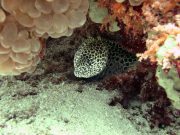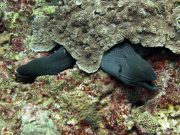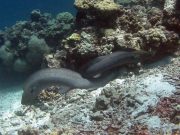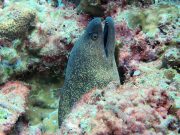Tauchen mit Muränen
Meeresleben von Lanta | Muraenoidei
Weltweit gibt es über 200 Muränenarten, die zwischen 10 cm und 3 m lang sind. Viele Arten leben bevorzugt in warmen tropischen Gewässern, und mehrere Arten können beim Tauchen um Koh Lanta gefunden werden.
Muränen verstecken sich oft in Riffspalten zwischen Felsen, Geröll und Hartkorallen, aus denen nur ihr Kopf herausragt. Einige Muränenarten lieben es, sich in riesigen Tonnenschwämmen niederzulassen.
Obwohl Muränen ein schlangenähnliches Aussehen haben, sind sie keine Reptilien, sondern Fische, die ihr Maul ständig öffnen und schließen, um das Wasser durch die Kiemen zirkulieren zu lassen, die sich in einiger Entfernung hinter dem Kopf befinden.
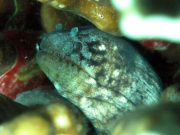
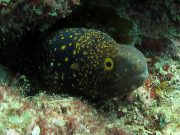

Die dicke Haut ist glatt, mit einem schützenden Schleim überzogen und oft gemustert. Eine ausgeprägte Rückenflosse verläuft vom Kopf bis zum Schwanz.
Muränen haben kleine Augen und sehen schlecht. Sie nutzen ihren Geruchssinn, um Beutetiere wie Fische, Krebse und Tintenfische aufzuspüren, die sie mit einem Überraschungseffekt fangen.
Da der Kiefer recht klein ist, wird größere Beute zunächst zerquetscht, indem der Körper um das Opfer gewickelt wird, bis es flach genug ist, um gefressen zu werden.
Sobald das Opfer von den Vorderzähnen gepackt wurde, wird ein zweiter, kleinerer Kiefer im Rachenraum, der so genannte 'Rachenkiefer', in Gang gesetzt, der die erbeutete Nahrung aufreißt und in den Rachenraum und das Verdauungssystem transportiert.
Im Jahr 1979 wurde in dem Film 'Alien' eine fiktive außerirdische Spezies gezeigt, die ihre Opfer mit einem Rachenkiefer angreift.
An den Tauchplätzen kann man manchmal beobachten, wie sich Muränen paaren, ihre Körper umeinander wickeln und über 5.000 Eier auf einmal legen und befruchten.
Nach dem Schlüpfen schwimmen die Muränenlarven in den offenen Ozean hinaus und leben über acht Monate lang im Plankton nahe der Oberfläche, bis sie groß genug sind, um sich zurück ins Riff zu wagen.
8 Arten auf dieser Seite gefunden:
- Blackspotted Moray (Gymnothorax favagineus)
- Giant Moray (Gymnothorax javanicus)
- White-Eyed Moray (Gymnothorax thyrsoideus)
- Yellow-edged Moray (Gymnothorax flavimarginatus)
- Zebra Moray (Gymnomuraena zebra)
- Snowflake Moray (Echidna nebulosa)
- Fimbriated Moray (Gymnothorax fimbriatus)
- Barred Snake Moray (Uropterygius fasciolatus)
Blackspotted Moray
(Gymnothorax favagineus)
The blackspotted moray (Gymnothorax favagineus), also known as the honeycomb moray, is a large eel which can grow up to 3m long, however most individuals are significantly smaller than this.
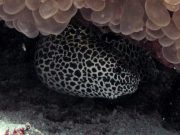
Gymnothorax favagineus @ Koh Haa
This moray is white with brown/black blotches and spaces, sometimes forming a honeycomb pattern. The blotches vary between individuals and size and depend on the eel's habitat. Those found in clear coral reefs usually have less black than those found in turbid waters.
The blackspotted moray lives on the outer slopes of coral reefs. During the day, it sits sheltered in crevices and at night it leaves its lair to actively hunt its prey along the reef. It feeds mainly on small fish and cephalopods.
Giant Moray
(Gymnothorax javanicus)
At up to 3m long, and weighing up to 30kg, in terms of body mass, the giant moray is the largest moray eel.
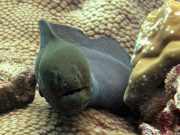
Gymnothorax javanicus @ Koh Haa
The giant moray feeds mainly on fishes and occasionally on crustaceans, and due to its position at the top of the reef's food chain, this eel is often ciguatoxic - the moray can absorb and store toxins from other reef fish in its body fat, and is poisonous if eaten by humans.
The body is deep with a strongly tapered tail and has a greyish, brownish background color, with juveniles being lighter in color. Black around the gill opening. Adults have black specks on the head that resemble leopard spots further back on the body.
The giant moray has several large sharp canines on both the upper and lower jaw alongside rows of smaller, sharp teeth.
Will attack humans if provoked, and sometimes just for fun.
White-Eyed Moray
(Gymnothorax thyrsoideus)
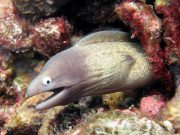
Gymnothorax thyrsoideus @ Anemone Reef
The white-eyed moray is a medium-sized fish which can grow up to 65cm, but is most usually found around 35 - 45cm. The head is grey with distinctive white eyes.
The body is serpentine in shape, speckled with small dark spots, and has an overall pale brownish/beige color that can vary in strength between different eels.
This eel can often be found sharing its nook or cranny with other moray eels, and sometimes groups of 3 - 5 white-eyed moray can be found together.
The white-eyed moray feeds on crustaceans, small fishes and octopus.
Yellow-edged Moray
(Gymnothorax flavimarginatus)
The yellow-edged moray is similar to the giant moray, but slightly smaller, with a maximum length of around 2.4m.
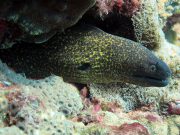
Gymnothorax flavimarginatus @ Koh Haa
This moray is yellowish with a densely mottled dark brown pattern and orange(ish) eyes. The head is a purplish-grey colour, and the end of the tail has a yellow margin. This moray also has black blotches at the gill openings.
Eats fish, including poisonous fish such as lionfish, crustaceans and possibly octopus.
Zebra Moray
(Gymnomuraena zebra)
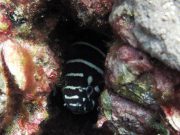
Gymnomuraena zebra @ Koh Haa
The zebra moray eel is a tan to dark brown moray with irregular close-set narrow white to pale yellow bars or bands, giving rise to its common name.
Even though the zebra moray can reach lengths of up to 1.5m, it is more usually observed around 45 - 55cm.
Gymnomuraena zebra actively hunt their prey at night, and unlike other moray eels, they feed almost exclusively on crustaceans, sea urchins and mollusks.
This eel has a short snout and close-set pebble-like teeth used for crushing hard-shelled prey. Totally harmless to humans.
Snowflake Moray
(Echidna nebulosa)
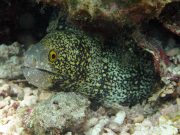
Echidna nebulosa @ Koh Haa
The snowflake moray has a pale body, generally yellowish/white, with rows of black blotches/bands, yellow eyes and yellow front nostrils.
Reaching up to 1m long, this moray is more usually observed in with 50 - 70cm range.
This moray feeds both during the day, and at night, with shrimp, crabs or lobsters (crustaceans) being their natural diet.
As with other moray eels, their eyesight is modest, compensated by a perfect sense of smell, thanks to two anterior nostrils and two posterior ones shaped like a small tube. The front nostrils point downwards, at the extremity of the snout, and the second ones upwards, at the level of the eye. These nostrils form a sort of all-round smelling radar for hunting, both during the day, and at night.
Completely harmless to humans.
Fimbriated Moray
(Gymnothorax fimbriatus)
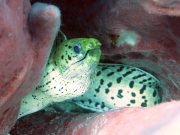
Gymnothorax fimbriatus @ Koh Haa
The Fimbriated Moray is a medium sized Moray with a light body color, often whitish, cream or light/pale brown.
The body is covered in many dark spots and blotches which vary with age. These dark spots and blotches are often in small groupings or rows.
The head is yellowish or pale greenish with dark spots and blotches. The mouth is white inside, also with many small black spots.
The Fimbriated Moray grows up to 80 cm and is usually hidden during the day, preferring to feed at night on small fish and crustaceans.
Barred Snake Moray
(Uropterygius fasciolatus)
Main body colour ranges from pale to dark grey with dark bars along the main body. Both upper and lower jaws with rows of fine, sharp teeth. Dark lines behind the eyes. Large secondary nostrils above the eyes.
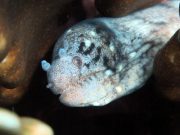
Uropterygius fasciolatus @ Koh Haa
Found in shallow reefs at depths between 1 and 8m. Hides during daytime and hunts prey during evening hours when it feeds mainly on smaller fish and crustaceans.
This is a very uncommon species and rare to find in the eastern Indian Ocean.
Tauchen mit Muränen rund um Koh Lanta
Tauch- und Schnorchelausflüge
Wenn Sie gerne die Gelegenheit hätten, Muränen auf einem unserer täglichen Tauchausflüge während der Hochsaison von Koh Lanta aus zu sehen, dann senden Sie uns eine E-Mail an info@diveandrelax.com.
Nehmen Sie an unseren Speedboot-Tauchausflügen in der Hochsaison zu einigen der besten Tauchplätze Thailands teil und genießen Sie kleine Gruppen, kurze Fahrzeiten und einen Fokus auf hervorragenden persönlichen Service, Sicherheit und Spaß.
Noch kein zertifizierter Taucher? Lernen Sie auf Koh Lanta das Tauchen mit dem 3-tägigen SSI Open Water Diver Kurs.
Buchen Sie online und sparen Sie 10% auf Tauchausflüge und Tauchkurse auf Koh Lanta.
Weitere Informationen
Indo-Pazifische Meereslebewesen-Führer
- Allen, G., Steene, R., Humann, P., DeLoach, N. (2003) Reef Fish Identification, Tropical Pacific. Jacksonville, FL., USA: New World Publications, Inc., ISBN 1-878348-36-1.
- Humann, P., DeLoach, N., (2010) Reef Creature Identification, Tropical Pacific. Jacksonville, FL., USA: New World Publications Inc., ISBN 978-1-878348-44-9
- Debelius, H. (2013) Indian Ocean Reef Guide. Frankfurt, Germany: IKAN - Unterwasserarchiv, ISBN 978-3-939767-52-7.
- Debelius, H. (2004) Nudibranchs and Sea Snails, Indo-Pacific Field Guide. Frankfurt, Germany: IKAN - Unterwasserarchiv, ISBN 3-925919-51-1
- Erhardt, H., Knop, D. (2015) Corals Indo-Pacific Field Guide. Frankfurt, Germany: IKAN - Unterwasserarchiv, ISBN 3-925919-69-4.
- Veron J.E.N., Stafford-Smith M.G., Turak E. and DeVantier L.M. (2016). Corals of the World
Weitere Referenzen zu Meereslebewesen und weitere Informationen




